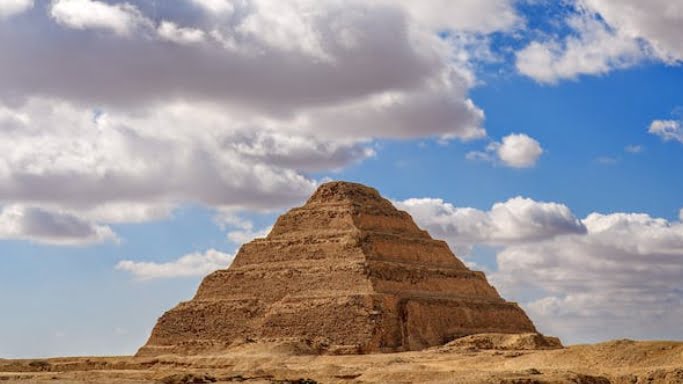In this post from IELTS game, we will give you answers location and explanation of the IELTS reading passage THE STEP PYRAMID OF DJOSER from Cambridge IELTS 16 Reading test 2

THE STEP PYRAMID OF DJOSER IELTS Reading Answers
| Questions | Answers |
|---|---|
| 27 | D |
| 14 | iv |
| 15 | vii |
| 16 | ii |
| 17 | v |
| 18 | i |
| 19 | viii |
| 20 | vi |
| 21 | city |
| 22 | priests |
| 23 | trench |
| 24 | location |
| 25 | B/D |
| 26 | B/D |
The Step Pyramid of Djoser IELTS reading Answers locations and explanations
QUESTIONS 14-20
Reading Passage 2 has seven paragraphs, A-G.
Choose the correct heading for each paragraph from the list of headings below.
Write the correct number, i-ix, in boxes 14-20 on your answer sheet.
14. Answer: iv
This passage talks about the importance of the pyramids and that there is a lot of controversy regarding it. However, it is a fact that it all started with King Djoser’s Step pyramid. The phrase there is no question expresses certainty, which is equivalent to a certainty (title iv). Controversial information can be understood as less define facts (define = determined). Thus, paragraph A is equivalent to heading iv.
- Answer: iv
15. Answer: vii
Talk about King Djoser being the first king to use stone material and new design and that was Imhotep’s idea. There is much controversy surrounding the reign of the king. Thus, during the reign of King Djoser, there was a change in the design of the tombs (burial structures). In this paragraph about ideas, we can compare and immediately pay attention to the heading vii. An idea for changing the design of burial structures. The answer to question 15 is vii.
- Answer: vii
16. Answer: ii
This paragraph shows that there were many different steps and plans in the design and construction process of this building, before it became the Step Pyramid with 6 stone floors, and this made it very difficult for the builders when having to bring up the stone slabs and push them inside. This is a task and very difficult (those who involved). Title ii is the appropriate title.
- Answer: ii
17. Answer: v
This paragraph D has been well understood by the candidate by answering the other questions in the passage. This paragraph is about the surrounding area outside this building. We look in the titles for keywords or synonyms for keywords like surroundings or outside. And in header v, we see external. Read the title carefully: An overview of the external buildings and areas . Thus, we find this title appropriate.
- Answer: v
18. Answer: i
This passage talks about what was found in the tomb. We look for words and synonyms for inside, in, internal, etc. Title i refers to within the pyramid itself, so we should pay attention to read the entire title. “ The areas and artefacts within the pyramid itself”. This paragraph E is indeed a description of the area and artifacts within the pyramid. However, we also need to pay attention to the title viii – an incredible experience despite a few remains due to the mention of “remains” – the remnants, synonymous with the artefacts. However, This passage does not refer to the feelings or thoughts of the archaeologists to create an incredible experience. Therefore, we exclude this title for paragraph E, which we can use for paragraph F – the next paragraph also talks about what is found inside the tomb. This passage says: There was enough left throughout the pyramid and its complex, however, to astonish and amaze the archaeologists who excavated it. expressing the emotions of archaeologists. astonish and amaze is what makes an incredible experience. viii is the answer to the passage F
- Answer: i
19. Answer: viii
This passage talks about what was found in the tomb. We look for words and synonyms for inside, in, internal, etc. Title i refers to within the pyramid itself, so we should pay attention to read the entire title. “ The areas and artefacts within the pyramid itself”. This paragraph E is indeed a description of the area and artifacts within the pyramid. However, we also need to pay attention to the title viii – an incredible experience despite a few remains due to the mention of “remains” – the remnants, synonymous with the artefacts. However, This passage does not refer to the feelings or thoughts of the archaeologists to create an incredible experience. Therefore, we exclude this title for paragraph E, which we can use for paragraph F – the next paragraph also talks about what is found inside the tomb. This passage says: There was enough left throughout the pyramid and its complex, however, to astonish and amaze the archaeologists who excavated it. expressing the emotions of archaeologists. astonish and amaze is what makes an incredible experience. viii is the answer to the passage F
- Answer: viii
20. Answer: vi
The surviving titles are A king that saved his people (no information about King Djoser saving the country, people); An answer to unexpected questions (this last paragraph re-emphasizes the importance and significance of the Step Pyramid, no questions asked). So the remaining title is A pyramid design that others copied. This title matches the last sentence of the paragraph: The Step Pyramid was a revolutionary advance in architecture and became the archetype which all the other great pyramid builders of Egypt would follow. The fact that the great pyramid builders will follow (follow) the Step Pyramid, which means that the design of this pyramid will be copied by the pyramids / others.
- Answer: vi
QUESTIONS 21-24
Complete the notes below.
Choose ONE WORD ONLY from the passage for each answer.
Write your answers in boxes 21-24 on your answer sheet.
21. Answer: city
- Key words: complex, surroundings, big
From the keyword complex and surroundings, we can determine the answer in the passage about the complex around this pyramid, paragraph D: The complex in which it was built was the size of a city in ancient Egypt and included a temple, courtyards, shrines, and living quarters for the priests. This complex is about the size of a city in ancient Egypt, that is, it is as big as an oversized Egyptian city (Egyptian city of the past). Thus, city is the answer.
The size = as big as
Ancient = of the past
- Answer: city
22. Answer: priests
- Key words: outside, include, accommodation, occupied
Verse 22 goes on to ask about the area outside the pyramid, and not about the area anymore but what it consists of. We find it in the reading: included a temple, courtyards, shrines, and living quarters for the priests. Living quarters means living and living areas, synonymous with accommodation; Temples, coutyards and shrines areas can be considered as many other buildings and features. The word to enter after the phrase occupied by (to be occupied, to be occupied by), means that we need to find the user of this living area. Priests are the answer.
Living quarters = accommodation
- Answer: priests
23. Answer: trench
- Key words: a wall, fall entrances, the outside of the complex, encircle
The question focused on area information outside the complex, in addition to a wall and dummy passages. Information about this area is found in the following sentences : It covered a region of 16 hectares and was surrounded by a wall 10.5 meters high. The wall had 13 false doors cut into it with only one true entrance cut into the south-east corner; the entire wall was then ringed by a trench 750 meters long and 40 meters wide. The complex is surrounded by a wall, so that is the wall that runs around the complex, mentioned in the question. False doors are fall entrances. Thus, the remaining object is a trench. In the reading passage, the author uses the entire wall was then ringed, which means that the trench encircle the wall. The answer is trench.
Ringed = encircled
- Answer: trench
24. Answer: location
- Key words: visitors, not invited, prevented, real entrance
Visitors who had not been invited can be understood as unwanted visitors. We focus on the sentence about this object: If someone wished to enter, he or she would have needed to know in advance how to find the location of the true opening in the wall. These objects, if they want to enter, will have to know in advance the location of the real entrance at this wall, or the real entrance, instead of the false entrances mentioned before. Thus, location is the answer to look for.
Not invited = unwanted
- Answer: location
QUESTIONS 25-26
Choose TWO letters, A-E.
Write the correct letters in boxes 25 and 26 on your answer sheet
With this type of question, we need to use the elimination method for each choice.
- Option A
Key words: initially, persuaded, stone, clay
There is no information about King Djoser disagreeing with the construction materials of the tomb, only that he was the first to use stone, and the person who came up with the idea was Imhotep. So this answer is not correct
- Option Abandon
Key words: disagreement, the length, reign
When it comes to disagreements in research, one must find at least two different conclusions about the subject being studied. Thanks to the keyword, we find information related to his reign. The last sentence of paragraph 2 contains this information: Djoser is thought to have reigned for 19 years, but some historians and scholars attribute a much longer time for his rule, owing to the number and size of the monuments he built. Originally, King Djoser was said to have reigned for 19 years, then from the contrasting conjunction “but”, one can guess that there is a contradiction here. And the latter is about how some historians think he reigned for a much longer time. His rule can be understood as synonymous with his reign (rule = reign). Answer B is correct.
- Option C
Key words: fail, appreciate, Imhotep’s design, Step Pyramid
The name Imhotep appears in paragraphs B and D of the reading. In paragraph B, the author refers to Imhotep’s idea, with no other connection. In paragraph D, there is a sentence: Djoser was so proud of his accomplishment that he broke the tradition of having only his own name on the monument and had Imhotep’s name carved on it as well . The king was so proud of the result that he broke with the tradition that only the king’s name was engraved on the structure, which he had Imhotep’s name engraved. The engraving of this name certainly shows great respect, it is impossible to say that the king failed to appreciate Imhotep’s design. This answer is wrong.
- Option EASY
Key words: a few, possessions, tomb, archaeologists
When talking about the things that archaeologists find, we need to focus on paragraphs E and F. There is a sentence: all archaeologists found were a small number of his valuables overlooked by the thieves . A small number can be understood as a few and valuables are possessions (assets, precious things). Thus all they found was a small amount of the king’s possessions that had been overlooked by the thieves. In other words, some of the king’s possessions were still in the tomb when archaeologists found them. This sentence is correct.
- Option E
Key words: critise, other pyramids
There is no information about King Djoser disparaging other pyramids. This answer is wrong.
- Answer: B and D
Read also:
